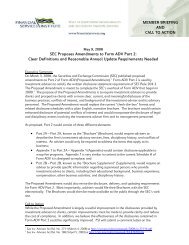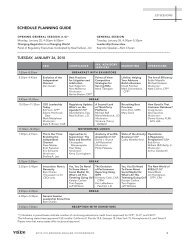KENNETH M. CHERRIER,JD, FLMI - Financial Services Institute
KENNETH M. CHERRIER,JD, FLMI - Financial Services Institute
KENNETH M. CHERRIER,JD, FLMI - Financial Services Institute
You also want an ePaper? Increase the reach of your titles
YUMPU automatically turns print PDFs into web optimized ePapers that Google loves.
was so well run that Miller took in more than a million dollars before the scam wasuncovered by the New York Herald. 10Who was Charles Ponzi?So if the scam was around prior to Ponzi, why is it named after him? To answer thatquestion, we need to look at the life of Charles Ponzi to understand how his Peter/Paulscam made such a significant impact on American culture that we renamed the scam inhis name.Born in Lugo, Italy on March 3, 1882, Carlo Pietro Giovanni Tebaldo Ponzi was the sonof a middle class postman and mother hailing from a family of Italian aristocrats. 11Charles’ mother, Imelda Ponzi, had lost her status of Italian royalty as a result of“marrying down” to a commoner. Nineteenth century Italy was extremely class consciousand as a result of her marriage, Imelda had placed all her hopes in her only son Charles torestore the family’s good name. It was the pressure from his mother that would set thestage for Charles’ desire for wealth early on in life.His family sent Charles at a young age to a prestigious private boarding school run byNapoleon Bonaparte’s second wife, Princess Marie-Louise. While away at school,Charles’ father past away. And although greatly saddened, Charles worked hard, receivedgood grades and eventually gained admittance to the University of Rome.Inheritance from his father's death and some money from an aunt would have beenenough to get Charles through school if he was thrifty. But it seems the dangers of goingoff to college in the late 1800’s were very similar to the perils faced by today’s unfocusedyouth: young Ponzi began to party. He befriended the wealthy students, adopting theirmanners, speech, social habits as well as their reputable talent for spending. He dressed inthe latest fashions, picked up restaurant tabs, refined his taste for opera and gambled inthe underground casinos of Rome. Finally his limited funds ran out and at 21, Charleswas forced to leave the University penniless.Returning home ashamed he had failed his widowed mother, Charles soon was provideda second opportunity to restore the family’s name. Charles’ uncle had suggested he makehis fortune in America where the streets were paved with gold. All one had to do wasreach down and scoop it up. It seemed like the perfect chance for someone like Charles,well spoken and well schooled in the mannerisms of the wealthy, to redeem his family’ssocial status and satisfy his desire for fortune and fame.On November 3, 1903, he left for Boston on the S.S. Vancouver with the last of hismother's money: about $200. Although the trip lasted only a week, unfortunately it was aweek too long for the young Ponzi who had grown accustom to the finer things in life.While on the ship, he gambled, drank and tipped big. By the time the ship docked inBoston, Charles had just $2 in his pockets. Even at the early age of 21, a trend that wouldbe the end of Charles Ponzi was emerging: his need for wealth and spending it.10 A million dollars in 1899 would be roughly $22 million measured in today’s dollars.11 Upon arriving in America and not speaking any English, Ponzi’s first name was changed from Carlo toCharles. The middle names were all dropped.





